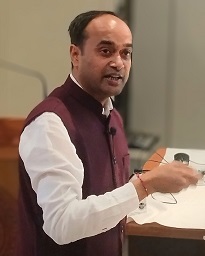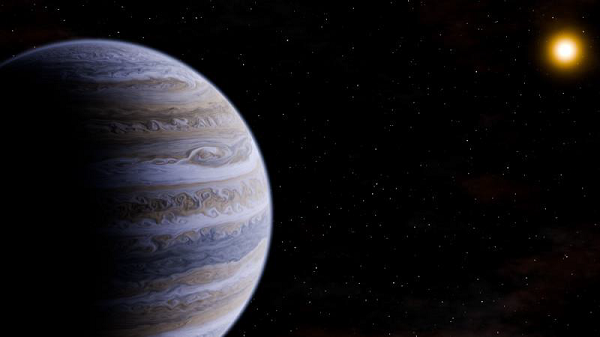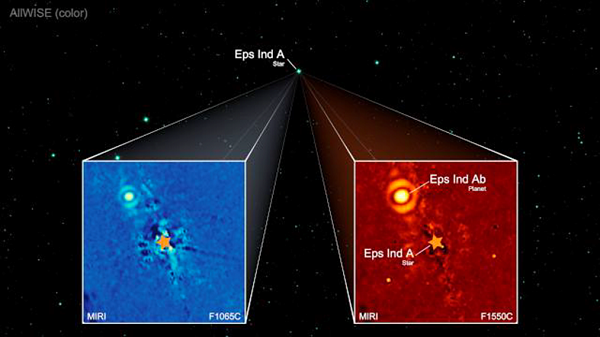Announcement
Events
Seminars
Latest News
Labs
Outreach
Welcome Message from HOD
 I am delighted that I.I.T. Kanpur has recently established the department of Space, Planetary & Astronomical Sciences & Engineering. Given the rapid pace of development in this field and the fascination it holds for students, I personally feel that this is a welcome step. India is currently pushing for a very ambitious space program and has established several major astronomical observatories. It is also participating in several international astronomical mega-science projects. We aim to create a stimulating environment in the department so that students can participate and effectively contribute to such research and development programs.
I am delighted that I.I.T. Kanpur has recently established the department of Space, Planetary & Astronomical Sciences & Engineering. Given the rapid pace of development in this field and the fascination it holds for students, I personally feel that this is a welcome step. India is currently pushing for a very ambitious space program and has established several major astronomical observatories. It is also participating in several international astronomical mega-science projects. We aim to create a stimulating environment in the department so that students can participate and effectively contribute to such research and development programs.
Prof. Amitesh Omar
Head, Department of Space, Planetary & Astronomical Sciences & Engineering
IIT Kanpur
Kanpur-208016
Email: head_spase@iitk.ac.in , aomar@iitk.ac.in
- Evidence of a Hardening in the Cosmic Ray Proton Spectrum at around 166 TeV Observed by the GRAPES-3 Experiment, Phys. Rev. Lett., F. Varsi et al. (GRAPES-3 collaboration), 2024, 132, 051002
- Probing atmospheric effects using GRAPES-3 plastic scintillator detectors, European Physical Journal C, M. Zuberi et al. (GRAPES-3 collaboration), 2024, 84, 255
- A study of dipolar signal in distant Quasars with various observables, European Physical Journal C, R. Kothari, M. Panwar, G. Singh, P. Tiwari and P. Jain, 2024, 84, 75
- Small-scale Cosmic-Ray Anisotropy Observed by the GRAPES-3 Experiment at TeV Energies, Astrophysical Journal, M. Chakraborty et. al. (GRAPES-3 collaboration), 2024, 961, 87
- Indentation of geometrically exact adhesive beams. Suryanarayanan, K., T. Bhuvana, I. Sharma, and S. L. Das 2023. Int. J. Solids Struct. 279, 112348:1-19.
- Equilibria of liquid drops on pre-stretched, nonlinear elastic membranes through a variational approach. Nair, V. and I. Sharma 2023. Phys. Fluids. 35, 047111:1-14.
- Equilibrium shapes of liquid drops on pre-stretched, nonlinear elastic membranes. Nair, V., I. Sharma, and V. Shankar 2023. J. Fluid Mech.. 961, A28:1-27.
- Indentation of geometrically exact beams. Suryanarayanan, K., I. Sharma, and S. L. Das 2022 Int. J. Struct. Solids 254, 111905.
- Correlations between QPO frequencies and spectral parameters of GRS 1915+105 using AstroSat observations,
Ruchika Dhaka, Ranjeev Misra, J.S. Yadav, Pankaj Jain, MNRAS, 524 (2023) 2, 2721-2732 - The comptonizing medium of the black hole X-ray binary MAXI J1535−571 through type-C quasi-periodic oscillations,
Rawat et al, MNRAS, 520 (2023) 1, 113-128 - Probing cosmology beyond LCDM using SKA,
Shamik Ghosh, Pankaj Jain, Rahul Kothari, Mohit Panwar, Gurmeet Singh, Prabhakar Tiwari
J.Astrophys.Astron. 44 (2023) 1, 22 - A toy model for low-energy nuclear fusion, Kaanapuli Ramkumar, Harishyam Kumar, Pankaj Jain
Pramana 97 (2023) 3, 109 - Validating the improved angular resolution of the GRAPES-3 air shower array by observing the Moon shadow in cosmic rays,
D. Pattanaik et al (GRAPES-3 collaboration), Phys.Rev.D 106 (2022) 2, 022009 - Dipole anisotropy in gravitational wave source distribution, Gopal Kashyap, Naveen K. Singh, Khun Sang Phukon, Sarah Caudill, Pankaj Jain,
JCAP 06 (2023) 042 - Image plane detection of FRB121102 with the MeerKAT radio telescope
J C Andrianjafy, N Heeralall-Issur, A A Deshpande, et al MNRAS 518, 3462 (2023) - A minimal space interferometer configuration for imaging at low radio frequencies
Jaini, A., Deshpande, A. A., and Bitragunta, S. 2021, PASA, 38, e040. - A Comparison of Multi-Phase Magnetic Field Tracers in a High-Galactic Latitude Region of the Filamentary Interstellar Medium
Campbell, J. L., SE Clark, S. E., Gaensler, B. M., Marchal, A., Van Eck, C. L., Deshpande, A. A., George, S. J., Gibson, S. J., Ricci, R., Stil, J. M., Taylor, A. R. 2022, ApJ, 927, 49. - Time-resolved spectroscopy on the heartbeat state of GRS 1915+105 using AstroSat, D. Rawat, R. Misra, P. Jain and J.S. Yadav. Published in: Mon. Not. Roy. Astron. Soc. 511 (2022) 2
- Superhorizon Perturbations: A Possible Explanation of the Hubble–Lemaître Tension and the Large-scale Anisotropy of the Universe, P. Tiwari, R. Kothari and P. Jain, Astrophys. J. Lett. 924 (2022) 2, L36
- Explaining excess dipole in NVSS data using superhorizon perturbation, K. K. Das, K. Sankharva, P. Jain, JCAP 07 (2021) 035
- Testing evolution of LFQPOs with mass accretion rate in GRS 1915+105 with Insight-HXMT, H. Liu, L. Ji, C. Bambi, P. Jain, R. Misra et al., Astrophys. J. 909 (2021) 1, 63
- General Treatment of Reflection of Spherical Electromagnetic Waves from a Spherical Surface and its Implications for the ANITA Anomalous Polarity Events, P. Dasgupta and P. Jain, Astroparticle Physics 128 (2021) 102530
- Granular flow on a rotating and gravitating elliptical body 2021, K Gaurav, D Banik, I Sharma, P Dutt, Journal of Fluid Mechanics 916, A40:1-40, 2019.
- Structural integrity of rubble asteroidal satellites, I Sharma, Icarus 319, 770-784
- Rings of non-spherical, axisymmetric bodies, A Gupta, S Nadkarni-Ghosh, I Sharma, Icarus 299, 97-116, 2018.
An Introductory Workshop on Exoplanet on Detection and Characterization: From Observation to Understanding the Science of Exoplanets
April 4-6, 2025 at IIT Kanpur, India
Link for the workshop: https://sites.google.com/view/exows25
Lecture Series on "Relative motion between satellites", by Prof. Arun Misra, Distinguished Visiting Faculty in the SPASE dept. Details can be found here
Visit by IITK alumnus Rajiv Desai (July 2024)
Dr. Rajiv Desai, a distinguished alumnus of IIT Kanpur and a pioneer in robotics and AI, recently visited the Department of SPASE, IITK. He delivered an inspiring talk on the Mars Pathfinder mission, the scale and challenges, and the role of autonomous vehicles in space exploration. Dr. Desai also engaged with students, discussing his journey from IITK to NASA's Jet Propulsion Laboratory and his ventures in entrepreneurship in space technology. His visit provided invaluable insights into the future of space missions and the integration of AI and robotics in space exploration.
National Space Day celebration August 24, 2024
Extraterrestrial space captures the imagination and curiosity of students and citizens across India. To celebrate this shared fascination, the Department of Space, Planetary & Astronomical Sciences & Engineering (SPASE) and the Department of Aerospace Engineering at IIT Kanpur proudly hosted National Space Day on August 24, 2024.
This year’s celebration was particularly special as it marked the first anniversary of Chandrayaan 3’s historic Moon landing. The event explored the present and future of the Indian space program through expert discussions, hands-on activities, and engaging astronomy outreach. It was a day of learning, inspiration, and pride as we came together to honour India’s achievements in space and envision the exciting possibilities that lie ahead.
It was a day of learning, inspiration, and pride as we came together to honour India’s achievements in space and envision the exciting possibilities that lie ahead.
For more information "click here"
view pictures click here
11th International Workshop on Very High Energy Particle Astronomy (VHEPA 2024) 17 Oct - 19 Oct 2024.
- Discovery of a new Feature in Cosmic Ray Spectrum
Dr. Fahim Varsi, doctoral student in Physics department working under supervision of Prof. Pankaj Jain (SPASE department) discovers a kink in the cosmic ray spectrum. It is generally expected that cosmic rays originate from a supernova explosion and display a simple power law spectrum up to energies of order of a million GeV. The presence of a kink challenges this understanding and indicates the presence of another source. The discovery may provide some important clues which may help in unravelling the mystery of the origin of cosmic rays.
The corresponding paper is published in Physical Review Letters:
Phys. Rev. Lett. 132, 051002 (2024) - Evidence of a Hardening in the Cosmic Ray Proton Spectrum at around 166 TeV Observed by the GRAPES-3 Experiment (aps.org) [1]Some popular articles on the discovery:
A new kink in proton spectrum to enhance our knowledge of cosmic ray origin (phys.org) [2]
A new kink in proton spectrum will enhance ou | EurekAlert! [3]
A new kink in proton spectrum will enhance our knowledge of cosmic ray (scienmag.com) [4]
A new kink in proton spectrum to enhance our knowledge of cosmic ray origin - Tech and Science Post [5]
Proton Spectrum Kink Boosts Understanding of Cosmic Ray Origin | Mirage News [6] - Dr. Prashant Pathak, faculty member in the Department of SPASE, discovers a new giant planet named Epsilon Indi Ab orbiting a nearby star similar to Sun. The corresponding paper in Nature, titled "A temperate super-Jupiter imaged with JWST in the mid-infrared" is available at:
https://www.nature.com/articles/s41586-024-07837-8. A newspaper article on the paper is available at: https://timesofindia.indiatimes.com/city/kanpur/iit-kanpur-assistant-professor-part-of-team-that-discovered-exoplanet/articleshow/112030744.cms

- Department of SPASE, along with the Department of Aerospace, has signed an MoU with Manastu Space, an emerging space tech company based in Mumbai. This partnership offers exciting opportunities for IIT Kanpur, especially in expanding our research into space-based services and technologies. Collaborating with a space-tech company like Manastu Space allows us to explore cutting-edge areas such as space robotics and propulsion systems. Additionally, our students will gain invaluable experience through internships and placements in a fast-growing sector. The collaboration will also enhance the skills of our researchers and faculty through exchange programs, making this a mutually beneficial relationship.
Manastu webpage: https://www.manastuspace.com/about - The outreach project from Dept of SPASE has been selected for the International Astronomical Union - Office for Astronomy Development (IAU-OAD) has been selected for a grant of 7000 Euros (P.I. Dr. Tejpreet Kaur & Amitesh Omar).
Admissions Open for MTech and PhD - Apply "here" New
For admission to the Ph. D. program.
A GATE qualified is required for the candidates with a Bachelor’s degree in Engineering, except in the case of candidates with Bachelor’s degree in Engineering from the centrally funded Technical Institutes (CFTIs). The candidates with Master’s degree in Science must either have a GATE qualified or must have qualified for/in JRF/NET.
Additionally, the candidate must satisfy any one of the following:
- A Master's degree in Engineering with marks/CPI not below the specified minimum.
[ The specified minimum is defined as the greater of the minimum pass marks / CPI and 55 percent marks / 5.5 CPI on a 10 point scale ] - Bachelor's degree in Engineering or Science (4-year programme) with a minimum of 75 percent marks/7.5 CPI and a GATE qualified.
The requirement of GATE score is waived for candidates with Bachelor's degree in Engineering from the centrally funded technical institutes (CFTIs). - A Master's degree in Science or an allied area while satisfying each of the following three criteria
- a minimum of 65 percent marks/6.5 CPI in the Master's degree,
- first division in bachelor's degree, and
- JRF/95 percentile or higher in GATE score.
- The requirement of GATE/JRF/NET/JEST is waived for candidates having a Master's degree in Sciences/arts from IITs, IISERs and NITs with a minimum CPI of 8.0.
Process of thesis supervisor selection (after admission into the Phd Programme)
The supervisor selection process starts towards the end of the first semester. Before the process starts, students are encouraged to interact with all faculty members in the department so as to figure out common interests of research with potential supervisors. The DPGC (Dept. Post Graduate Committee Convener) oversees this process. While the supervisor selection is based primarily on student's preferences, however, academic performance in the semester, openings with a faculty or a research group, and department/institute guidelines in force at that time can also be the determining factors. Prospective students may confirm an opening with faculty members of their choice (if any) by contacting DPGC ( This email address is being protected from spambots. You need JavaScript enabled to view it. ) in advance. The research interests and profiles of faculty members and presently enrolled students are listed on the department webpage.
1. PhD. Course Structure Click Here
2. MTech. Course Structure Click Here
Details of courses
Note: The suffix M to any course code implies modular (half-semester) course
UG Courses
SPA201 (9 credits) Introduction to Astronomy and Astrophysics
SPA401 (9 credits) Galaxies and Observational Cosmology
SPA402 (9 credits) Introduction to Manmade Satellite Systems and its Environment
SPA403M (5 credits) Observing the Milky Way galaxy - Our Home in the Cosmos
SPA404 (9 credits) Introduction to Space Technology
SPA405M (5 credits) Space Economics - Law, Policy and Benefits
PG Courses
SPA601 (9 credits) Introduction to space & astronomical instrumentation
SPA603 (9 credits) Solar system processes and space missions
SPA610 (9 credits) Fundamentals of Astronomy and Astrophysics
SPA611 (9 credits) Radio Astronomy
SPA613M (5 credits) Introduction to Celestial Observational Techniques
SPA614M (5 credits) Introduction to Celestial Mechanics
SPA616 (9 credits) Stars and Stellar Evolution
SPA617M (5 credits) Space Instrumentation Laboratory
SPA618M (5 credits) Introduction to radiative processes in space
SPA621 (9 credits) Planetary Surface Processes
SPA622M (5 credits) Mathematical Techniques in Space Sciences & Engineering
SPA623M (5 credits) Numerical Techniques in Space Sciences & Engineering
SPA624M (5credits) Optical Instrumentation Laboratory
SPA626 (9 credits) Space environment and Space systems
SPA627M (5 credits) Introduction to fluid mechanics in space
SPA631M (5credits) Statistical Methods and Applications in Space Sciences
SPA632M (5credits) Introduction to Mathematical Transforms and Applications in Space Sciences
SPA633 (7 credits) Introduction to Astrobiology
SPA634 (8 credits) Applied Optics: From Rays to Waves
SPA636 (5 credits) Radio instrumentation, observing techniques and data analyses (Radio Lab)
SPA637 (9 credit) Spacecraft Dynamics
SPA660 (9 credits) High Energy Astrophysics of Binary star systems
MTech admissions - GATE cutoff 2025 New
Admissions Open for MTech and PhD - Apply "here" New
For admission to the M. Tech. program.
Candidate must satisfy the following:
- A Bachelor's degree in Engineering or Science (4-year programme) or a Master's degree in Science with marks/CPI not below the specified minimum.
[ The specified minimum is defined as the greater of the minimum pass marks / CPI and 55 percent marks / 5.5 CPI on a 10 point scale ] - A GATE qualified is required for admission to the MTech programme in the case of regular (non-sponsored) candidates.
The candidate should have appeared in one of the following papers in the GATE examination:
AE, CE, CH, CS, DA, EC, EE, IN, MA, ME, MT, PH, ST, XE (papers BCDEH).
The requirement of GATE score is waived off for the candidates with the B Tech/BS (Four Year) degree from IITs with a minimum overall CPI of 6.5 and a minimum CPI of 8.0 in the last two years in B Tech/BS (Four Year).




